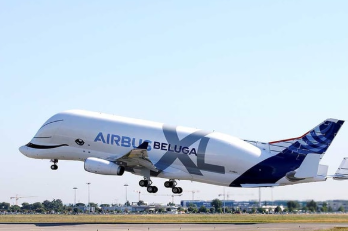Here are 12 Facts about the Beluga XL you need to know and share with Kids
1. Beluga XL made her first maiden flight in 2018
The Beluga XL made her first flight on 19th July 2018. The aircraft is due to enter service with Airbus Transport in early 2020 to replace the Airbus Beluga in the movement of oversized aircraft components, for example, wings. It received its type certification on 13 November 2019
2. The Airbus A300- 743 XL is only 5 Produced in the world by Airbus
The Beluga XL shares many design similarities, although substantially different in appearance, to the Airbus A300-600 ST, it was based upon. However, the Beluga XL is only 5 built worldwide by Airbus
3. Powering the Airbus A300-743XL whale airplane costs over one billion dollars.
As geeks will always say, a bigger plane means a bigger engine. In this case, two engines. The BelugaXL has two Rolls-Royce Trent 700 Turbofan engines to power it into the sky, costing about $40 M each. The entire program to build these flying giants cost over 1 billion. No wonder it’s only 5 built in the world.
4. The A330- 743 XL has the largest cargo volume of any aircraft in the world
The most useful feature of the Airbus Beluga XL is its massive cargo space. It was designed to have an extraordinarily cavernous internal space to accommodate payloads that feature large-sized and heavy components for transport. The Beluga is definitely a workhorse that can boast of being the “most volumetrically cavernous aircraft in the world.
5. Beluga ST will not be Withdrawn while the Beluga XL operates
The existing Belugas will not be withdrawn from service when the Beluga XL is introduced; a mixed fleet is to operate for at least five years as the increased production rate of single-aisle aircraft requires the ability to move more parts so that’s to say that the Beluga fleet will be flying 11 destinations in Europe.
The current Beluga fleet flew more than 8000 hours in 2017, doubled from 2014, but the five Beluga fleet is only at its half-life: another operator could use them for civil or military logistics applications.
The Beluga Fleet will help to strengthen Airbus’ industrial capabilities and enabling the company to meet its production and delivery commitments.
6. The Beluga XL is operated by 3 – member crew
The Airbus A300- 743 XL is operated by a three-member crew comprising two pilots and a loadmaster. The main instrument panel incorporates six cathode ray tube (CRT) displays that continuously provide flight, navigation, and systems-monitoring information in a clear, comprehensive manner.
7. The A300-743 XL Features semi-automated main deck cargo loading system
The semi-automated main deck cargo loading system of the Beluga XL ensures easy and efficient handling of payloads, controlled by the trained crews of Airbus Transport International – which operates the five-aircraft Beluga fleet.
8. The Beluga XL can carry two Airbus A350 wings Instead of one
With 30% more capacity than the existing Beluga (A300 – 600 ST), it will be able to carry two A350 XWB wings instead of one. Its new fuselage is 6.9 m longer and 1.7 metres wider than the Beluga, and it will be able to lift a payload 6 tonnes heavier.
9. General characteristics of Beluga XL you need to know. For more clarification, Please visit the Airbus A300- 743 page
Capacity: 50,500 kg (111,333 lb) payload
Length: 56.15 m
Wingspan: 44.84 m
Height: 17.24 m
Wing area: 44.84 m
Fuselage width: 7. 31 m
Max cabin width 5.28 m
Wheelbase: 11.05 m
Empty weight: 133.5 tonnes
Max takeoff weight: 155 tonnes
Max Landing weight: 144 tonnes
Fuselage diameter: 7.31 m
Max fuel capacity: 23,860 liters
Cargo hold: 2,209 m3 (78,000 cu ft) volume
Powerplant: 2 × Rolls-Royce Trent 700 turbofan, 316 kN (71,000 lbf) thrust each
Performance
Cruise speed: 737 km/h (458 mph, 398 km) , Mach 0.69 at FL350
Range: 4,300 km (2,600 mi, 2,300 NMI) at max payload
Service ceiling: 11,000 m (35,000 ft)
The Beluga XL will operate at Mach 0.69 up to 35,000 ft over 2,300 nmi instead of the original 900 nmi. Deharde Aerospace and the P3 group provide the upper fuselage while Aciturri produces the horizontal tailplane extension, auxiliary and ventral fins.
10. Beluga XL plane is larger than two blue whales.
At 56. 15 meters long, the BelugaXL is more than double the size of the blue whale (24-30 m.), the largest living mammal on Earth. No living mammal, extinct dinosaur or larger-than-life legend could compare. Although Smaug comes closest at 61 m.
11. The Airbus A300-743 XL forehead opens.
Perhaps you’re wondering, “How do they load aircraft wings into the plane?” Us, too. The logistics, however, don’t look as complicated as we thought. The BelugaXL’s “forehead” opens to allow crews to load and unload massive cargo, like plane wings. With this much storage space, the aircraft can fly 4,000 kilometers (2,485 miles) while carrying up to 50 tons.
12. The Outsize cargo freight aircraft can be unloaded in less than a half-hour
To be more precise, the front loading and unloading Beluga is completely designed for fast loading and unloading. Regardless of the size of the load, on average, it takes less than 30 minutes to unload.
Conclusion
Indeed Airbus manufacturing company has designed and produced a variety of aircraft just like Airbus A350 XWB, but you have to agree with me that one of the most unique was the Beluga model. You may have heard of it, but many people haven’t. You may have seen it but you haven’t touch it.
This craft has been used for the transport of Airbus components as parts for the past twenty-four years on 11 destinations.
Source: www.Flymags.com


